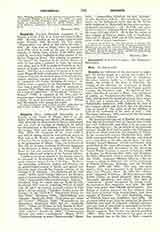

Ziegelbauer, MAGNOALD, historian, b. at Ellwangen, Swabia, 1689; d. at Olmutz, January 14, 1750. He took vows at the Abbey of Zwiefalten November 21, 1707, was ordained priest, March 21, 1713, and became professor of theology at his monastery. Soon, however, some illiterate monks of Zwiefalten manifested their aversion to the learned and studious Ziegelbauer, who obtained his abbot’s permission to reside at another monastery of his order. At first he went to Reichenau, where he taught theology. About 1730 the prior of this imperial monastery sent him to the court of Vienna on business pertaining to the monastery, after the successful accomplishment of which he taught moral theology at Gottweig from 1732-33, then returned to Vienna to devote himself to literary labors. In 1734 he became tutor of the young Barons von Latermann. From 1747 he resided at Olmutz as secretary of the learned club “Societas incognitorum”. His chief literary production is “Historia rei literariae ordinis S. Benedicti”, which was published posthumously by his friend and collaborator Oliverius Legipontius (4 vols., Augsburg, 1754) and still remains the standard literary history of the Benedictine Order. His other 19 printed works (see list in Lindner, loc. cit. below) include “Mancipatus illibatae virginis deiparae” (Constance, 1726); “Lebengeschichte des ertz-martyrers Stephani” (Vienna, 1736); “Epitome historica regii, liberii et exempti in regno Bohemiae antiquissimi monasterii Brevnovien-sis” (Cologne, 1740); and other historical and theological treatises of minor importance. Among his unprinted works are “Olomucium sacrum”, an ecclesiastical history of Moravia and its bishops, and “Bibliotheca, Bohemica”, a collection of writers on Bohemia.
MICHAEL OTT

